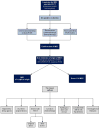Myelodysplastic syndrome after allogeneic hematopoietic stem cell transplantation: diagnostic and therapeutic challenges
- PMID: 22473867
- PMCID: PMC3454494
- DOI: 10.1002/ajh.23174
Myelodysplastic syndrome after allogeneic hematopoietic stem cell transplantation: diagnostic and therapeutic challenges
Figures

Similar articles
-
Allogeneic and autologous stem-cell transplantation in advanced Ewing tumors. An update after long-term follow-up from two centers of the European Intergroup study EICESS. Stem-Cell Transplant Programs at Düsseldorf University Medical Center, Germany and St. Anna Kinderspital, Vienna, Austria.Ann Oncol. 2000 Nov;11(11):1451-62. doi: 10.1023/a:1026539908115. Ann Oncol. 2000. PMID: 11142486 Review.
-
Allogeneic hematopoietic stem cell transplantation in elderly patients with acute myeloid leukemia or myelodysplastic syndromes: myth and reality.Leukemia. 2021 Jan;35(1):225-228. doi: 10.1038/s41375-020-1004-9. Epub 2020 Jul 30. Leukemia. 2021. PMID: 32733010 No abstract available.
-
Second allogeneic stem cell transplantation in a patient with hypoplastic myelodysplastic syndrome following a primary diagnosis of aplastic anaemia.Acta Haematol. 2011;125(3):175-8. doi: 10.1159/000322609. Epub 2010 Dec 30. Acta Haematol. 2011. PMID: 21196720 No abstract available.
-
Post-Transplant Cyclophosphamide Combined with Anti-Thymocyte Globulin as Graft-versus-Host Disease Prophylaxis for Allogeneic Hematopoietic Cell Transplantation in High-Risk Acute Myeloid Leukemia and Myelodysplastic Syndrome.Acta Haematol. 2021;144(1):66-73. doi: 10.1159/000507536. Epub 2020 May 19. Acta Haematol. 2021. PMID: 32428903
-
Selection of Patients With Myelodysplastic Syndrome for Allogeneic Hematopoietic Stem Cell Transplantation.Clin Lymphoma Myeloma Leuk. 2016 Aug;16 Suppl:S49-52. doi: 10.1016/j.clml.2016.02.023. Clin Lymphoma Myeloma Leuk. 2016. PMID: 27521324 Review.
Cited by
-
Lessons Learned from Donor Cell-Derived Myeloid Neoplasms: Report of Three Cases and Review of the Literature.Life (Basel). 2022 Apr 8;12(4):559. doi: 10.3390/life12040559. Life (Basel). 2022. PMID: 35455050 Free PMC article.
-
Case Report: Late Onset of Myelodysplastic Syndrome From Donor Progenitor Cells After Allogeneic Stem Cell Transplantation. Which Lessons Can We Draw From the Reported Case?Front Oncol. 2020 Oct 14;10:564521. doi: 10.3389/fonc.2020.564521. eCollection 2020. Front Oncol. 2020. PMID: 33178592 Free PMC article.
-
A Study of Human Leukocyte Antigen Mismatched Cellular Therapy (Stem Cell Microtransplantation) in High-Risk Myelodysplastic Syndrome or Transformed Acute Myelogenous Leukemia.Stem Cells Transl Med. 2016 Apr;5(4):524-9. doi: 10.5966/sctm.2015-0196. Epub 2016 Feb 2. Stem Cells Transl Med. 2016. PMID: 26838271 Free PMC article. Clinical Trial.
-
Current Advances and Challenges in Gene Therapies for Neurologic Disorders: A Review for the Clinician.Neurol Genet. 2025 Jan 13;11(1):e200229. doi: 10.1212/NXG.0000000000200229. eCollection 2025 Feb. Neurol Genet. 2025. PMID: 39810751 Free PMC article. Review.
-
Non-Ablative Chemotherapy Followed by HLA-Mismatched Allogeneic CD3+ T-Cells Infusion Causes An Augment of T-Cells With Mild CRS: A Multi-Centers Single-Arm Prospective Study on Elderly Acute Myeloid Leukemia and int-2/High Risk Myelodysplastic Syndrome Patients.Front Oncol. 2021 Oct 13;11:741341. doi: 10.3389/fonc.2021.741341. eCollection 2021. Front Oncol. 2021. PMID: 34722293 Free PMC article.
References
-
- Bishop MR, Alyea EP, 3rd, Cairo MS, Falkenburg JH, June CH, Kroger N, Little RF, Miller JS, Pavletic SZ, Porter D, Riddell SR, van Besien K, Wayne AS, Weisdorf DJ, Wu R, Giralt S. Introduction to the reports from the National Cancer Institute First International Workshop on the Biology, Prevention, and Treatment of Relapse after Allogeneic Hematopoietic Stem Cell Transplantation. Biol Blood Marrow Transplant. 2010;16:563–564. - PMC - PubMed
-
- Bishop MR, Alyea EP, 3rd, Cairo MS, Falkenburg JH, June CH, Kroger N, Little RF, Miller JS, Pavletic SZ, Porter DL, Riddell SR, van Besien K, Wayne AS, Weisdorf DJ, Wu RS, Giralt S. National Cancer Institute’s First International Workshop on the Biology, Prevention, and Treatment of Relapse after Allogeneic Hematopoietic Stem Cell Transplantation: summary and recommendations from the organizing committee. Biol Blood Marrow Transplant. 2011;17:443–454. - PMC - PubMed
-
- Rihani R, Bazzeh F, Faqih N, Sultan I. Secondary hematopoietic malignancies in survivors of childhood cancer: an analysis of 111 cases from the Surveillance, Epidemiology, and End Result-9 registry. Cancer. 2010;116:4385–4394. - PubMed
-
- Bhatia S, Krailo MD, Chen Z, Burden L, Askin FB, Dickman PS, Grier HE, Link MP, Meyers PA, Perlman EJ, Rausen AR, Robison LL, Vietti TJ, Miser JS. Therapy-related myelodysplasia and acute myeloid leukemia after Ewing sarcoma and primitive neuroectodermal tumor of bone: A report from the Children’s Oncology Group. Blood. 2007;109:46–51. - PMC - PubMed
-
- Miser JS, Goldsby RE, Chen Z, Krailo MD, Tarbell NJ, Link MP, Fryer CJ, Pritchard DJ, Gebhardt MC, Dickman PS, Perlman EJ, Meyers PA, Donaldson SS, Moore SG, Rausen AR, Vietti TJ, Grier HE. Treatment of metastatic Ewing sarcoma/primitive neuroectodermal tumor of bone: evaluation of increasing the dose intensity of chemotherapy--a report from the Children’s Oncology Group. Pediatr Blood Cancer. 2007;49:894–900. - PubMed
Publication types
MeSH terms
Grants and funding
LinkOut - more resources
Full Text Sources
Medical
